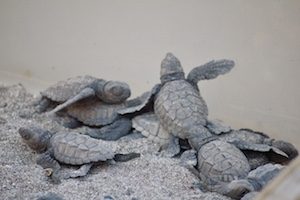By Joanne Reid
 The time is quickly approaching 6 p.m. as I hurry to the edge of the hotel property on the Bay of Banderas, Nuevo Vallarta, Mexico. Along my path are others headed in the same direction, animated at the thought of what they are about to witness. Enclosed in an area about the size of a tennis court are row upon row of markers and inverted wire cages labeled with dates of collection and predictions. This marks the green sea turtle sanctuary. There is much anticipation, and the children gather behind the lines drawn in the sand… NO CROSSING, NO TOUCHING, and NO CAMERA FLASH. The message is clear.
The time is quickly approaching 6 p.m. as I hurry to the edge of the hotel property on the Bay of Banderas, Nuevo Vallarta, Mexico. Along my path are others headed in the same direction, animated at the thought of what they are about to witness. Enclosed in an area about the size of a tennis court are row upon row of markers and inverted wire cages labeled with dates of collection and predictions. This marks the green sea turtle sanctuary. There is much anticipation, and the children gather behind the lines drawn in the sand… NO CROSSING, NO TOUCHING, and NO CAMERA FLASH. The message is clear.
About 50 baby sea turtles are about to be released. Wait… not until the sun is about to set, because before that time, the frigates, seagulls, and crabs pose too much danger.
About 45 days before this date a female sea turtle arrived on the beach to lay her eggs. She dug a hole approximately 18 inches deep and deposited 50 to150 eggs resembling golf balls. Unlike most eggs you may be familiar with, they are soft-shelled, so as not to crack upon deposit. The female then covered her eggs with sand and grass and departed, leaving them totally on their own.
“As many as 90 female turtles have been seen to come ashore at one time in the September to October months, to lay their eggs,” explained Ariel, one of the local biologists.
The biologists scan the beach each day for evidence of nests and gather and relocate the eggs to the enclosed area, tagging each grouping as to the date gathered and the estimated date for hatching. If the sand around the eggs is warm (over 85 degrees) the babies will be female. Cooler sand temperatures result in the birth of males. You cannot determine the turtle’s sex until they are older, when the male will have a longer tail.
 Upon hatching, nature has equipped the babies with a store of food that will last them 10 days. The eyes of the hatchlings are very sensitive to light; therefore, no flash from cameras or cellphones is allowed. Nor can they be handled, as their immune system will not tolerate lotions of any kind. We stand back a few feet to watch as these little ones scramble in every direction at first, but are ultimately drawn to the water’s edge. Slow progress, to be sure, but determined. You can see that in spite of the obstacles of stones, mounds of sand, and the wash of the waves, they will succeed.
Upon hatching, nature has equipped the babies with a store of food that will last them 10 days. The eyes of the hatchlings are very sensitive to light; therefore, no flash from cameras or cellphones is allowed. Nor can they be handled, as their immune system will not tolerate lotions of any kind. We stand back a few feet to watch as these little ones scramble in every direction at first, but are ultimately drawn to the water’s edge. Slow progress, to be sure, but determined. You can see that in spite of the obstacles of stones, mounds of sand, and the wash of the waves, they will succeed.
Once in the ocean they must surface every 30 to 45 minutes for air and as they grow they will venture further and further from their birthplace. They have been known to reach other continents in their explorations. Interestingly, though, having felt the sand beneath them, they are equipped with the knowledge of where they must return as an adult. The ocean, while being their home, is also a source of danger for them as they are a common food source for sharks, orcas, and seabirds. Likewise they feed upon fish, jellyfish, and crabs as juveniles, but as adults they feed on vegetation.
Unfortunately only one in 1,000 will survive, and so the cycle of life continues.
If you would like to purchase this article for your publication, please click here to contact the author directly.
